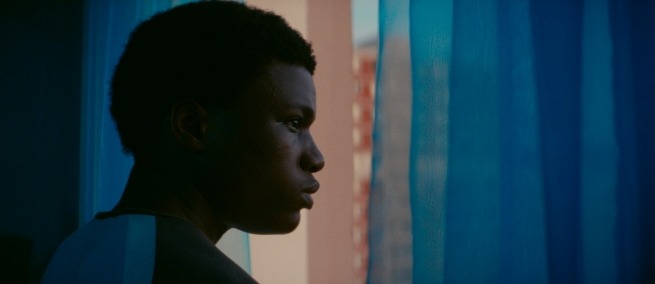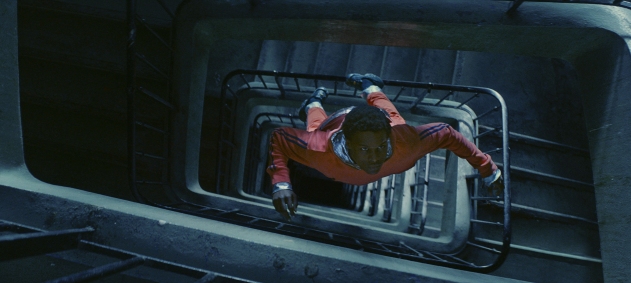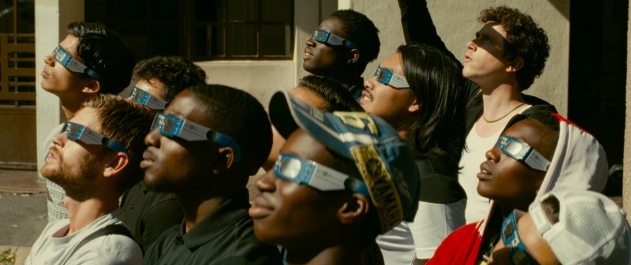
The acclaimed debut feature by Fanny Liatard and Jérémy Trouilh, GAGARINE, is set in a real housing development called Cité Gagarine built in the 1960s outside of Paris which housed mainly immigrant families. The building was named for the Soviet cosmonaut Yuri Gagarin, the first person in space. Liatard and Trouilh’s film was shot in the building before its demolition in 2019, and their main character Youri is a space enthusiast whose hobby becomes a means of life support when the building starts to shut down around him in preparation for its demolition.
GAGARINE made its world premiere at Cannes in 2020 and went on to win the Lumière Award for Best First Film, to receive a César nomination for the same category, and is now being distributed theatrically in the U.S. by Cohen Media Group. We spoke with Fanny Liatard and Jérémy Trouilh about the origins of the story, the production of the film, and their next projects.
Science & Film: Part of the fun of watching the evolution of Youri in GAGARINE is seeing all of the ingenious solutions he comes up with to make the building run. How did you think about how he would live there in a self-sustaining way?
Fanny Liatard: The idea of a spaceship came from the history of the place itself—the name of the building and the history of an astronaut coming to inaugurate it. But then, you’re right, the question became: What will this place where Youri will live alone and be self-sufficient become? We had the chance during the writing process to be at a residency at the National Space Center in France. The residency gave us access to many books and conferences about living in space. So, from one side we were looking at how life on the ISS is, how the walls look, what is the research on how to survive daily life in this place? What we made for the film had to be very practical and also a place that only Youri could have built. It is made of objects and furniture he could have found in the empty apartments around him. On the other hand, we were also very inspired by sci-fi movies. To survive he had to have food and water, so he had to have a garden—but also it was a dream for us to make a garden in an apartment. What he builds is half practical and half for dreaming: a control room, a room for the garden, and a room to watch the stars.

Still from GAGARINE. Courtesy of Cohen Media Group.
S&F: Can you speak a bit more about how the real building of Gagarine inspired the film?
Jérémy Trouilh: We’ve always been driven by the real building of Gagarine because we were lucky enough to shoot there before its demolition, and it was completely empty. With our construction team it became a game think of how in that building depending on the shape of the different apartments, how Youri would have adapted that configuration to his own dreams.
Fanny and I are very close friends, we studied Political Sciences together—we didn’t know we wanted to make films at that point—but after a few years of studying urban planning and travelling to South America, we arrived together in Paris wanting to make films. She had done a scriptwriting workshop and I had done one in documentary filmmaking, and we wanted to make fiction. That was 2015 and friends of ours, architects, invited us to discover Gagarine in the south of Paris. It was going to be demolished, but it was full of inhabitants at that time, and they wanted to make documentary portraits of those inhabitants before they left. From the very first day we met this building, we saw a spaceship, and we saw a possibility of telling a fictional story that would allow us to talk about the strengths of the community and the youth that have huge dreams. So, we were going back and forth from this building to Paris on Line 7 and we remembered about a contest of scriptwriting for short films, so we wrote the short film GAGARINE in two days. That was already the story of a young man looking at the building as a spaceship and dreaming of saving his community. We won the contest, and it gave us a very small amount of money to make our first film. We knew nothing. We had six months and felt it was the chance of our lifetimes, so we gave it our all. We had one phone number of a student from cinema school in Paris and then looked for a team through him, and that became the team we worked with on the feature we shot five years later.

Still from GAGARINE. Courtesy of Cohen Media Group.
From the beginning, we thought, this film had to be done with the inhabitants. We tried to involve the people in the process from the beginning. The short film wasn’t enough to tell the whole story, and we were lucky enough to meet two people from Haut et Court who wanted to know if we had a feature project, so we went all the way together from 2016 to today to create GAGARINE.
S&F: There is a dualism in your film where on the one hand, it the story of a lonely, self-sufficient person, and on the other it is the story of a community. How did you think about those opposing themes in the writing and production?
FL: The two topics were really present in all the writing, filming, and editing. It was a balance to find in the narrative. Our character is a lonely person, he’s a dreamer, but he can dream because he has this community around him, so that’s what we were thinking of while developing the character. He has no family so his family is the inhabitants, which is also why it’s so hard for him to say goodbye to the community. What we wanted to say with the film is that the strongest thing is the community, and they will save him in the end. Also, what Youri achieves is to find a way with his own tools to say something to the world. The lights are his language. The final SOS to the world speaks for all the young people who are growing up in territories with these stigmas on them, where it is hard for them to think about their future. It’s an SOS call to the world to pay attention to them and protect them and to see how strong and smart they are. It’s also an SOS to the community to tell them concretely to come help. Youri has the soul of an astronaut and is strong enough to be alone, but we don’t think anybody can be alone for too much time.

Still from GAGARINE. Courtesy of Cohen Media Group.
S&F: Have you shown the inhabitants the feature?
JT: Of course, it was a very emotional moment expected for a long time because the film was finished by mid-2020 but it was in the middle of COVID. It was in Cannes but there was no Cannes, so this moment we were expecting of climbing the red carpet with all the inhabitants of Gagarine couldn’t happen. When the cinemas reopened we organized a Cannes festival at the foot of the former Gagarine where there is a local cinema. We screened GAGARINE and it was beautiful because in the film there are inhabitants involved in many steps; many are in the film in the collective scenes, there are some actors also. They were all at the screening and we were in a big theater and at the end we said, everyone who participated in the film come up, and then there was no audience left [laughs]. It was their film as much as ours.
S&F: What are you working on next?
JT: We are in the process of writing our next features. We’re developing two different projects, one in the U.S. and one in France. We just came back from three months residency in New York at the Villa Albertine in Harlem. This new story somehow links with GAGARINE because it talks about youth, community, and has some social grounding but also some sci-fi aspects. We are also working on a feature that will take place in France, in the middle of the forest. It begins with a territory also, and with a story that says something about the injustice of our world and resilience of people.
♦
GAGARINE is written and directed by Fanny Liatard and Jérémy Trouilh, and co-written by Benjamin Charbit. It is produced by Julie Billy and Carole Scotta. The film is currently playing in theaters.
TOPICS